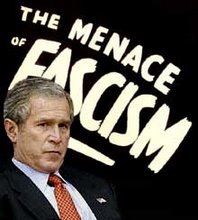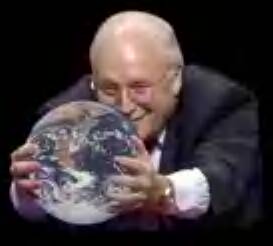BURMA:
Monks Lead Protests, Challenge Junta
Moe Yu May and Marwaan Macan-Markar
RANGOON, Sep 25 (IPS) - Like they did for over a week, the monks who gathered at Burma’s most sacred site -- the Shwedagon pagoda -- performed a ritual on Tuesday under a blistering mid-day sun. They sat on the hallowed grounds of the majestic temple in Rangoon to pray for the people’s ‘victory'.
It was a moment that moved a female Burmese writer who was among the hundreds of people lending solidarity to the men dressed in their distinct dark orange or crimson robes. She delivered a line that echoed the sentiment of many ordinary Burmese: ‘’It is going to be a terrific moment in the country’s history.’’Tuesday's ritual took on dramatic significance, coming as it did in the face of threats made by the country’s oppressive military regime to quell the street protests led by thousands of monks. On Monday night, the country’s religious minister, Brig. Gen. Thura Myint Maung, issued a warning to the members of the defiant clergy, saying, ‘’If the monks go against the rules and regulations in the authority of Buddhist teachings, we will take action under existing law.’’
In Mandalay, Burma’s historic capital that is also home to the largest Buddhist education centre, more menacing threats came from the junta. Printed notices appeared in the evening warning people to stay at home and avoid future demonstrations or ‘’soldiers will open fire,’’ said a Burmese human rights activist with contacts in that central city.
The prospect of bloodshed loomed large in Rangoon, Burma’s commercial capital as Tuesday dawned. Armed riot police were seen taking positions behind barbed wire barricades in one area, blocking off a street near a prominent pagoda. Government trucks with loudspeakers drove through neighbourhoods warning citizens to avoid joining in another day of protest.
But such threats from a regime notorious for its brutality failed to dam the rage that has bubbled to the surface among a broad swath of Burmese society. Estimated crowds of some 100,000 people, led by close to 30,000 monks, took to the streets along a route that began at the Shwedagon pagoda, headed to the Sule pagoda and made its way to the Botatung pagoda, located close to the Rangoon river, south of the city.
On the way -- and in a further show of defiance -- the demonstration stopped close to the city hall for a round of critical public speeches directed at the military dictatorship. It was a spot rich in symbolism, for it was there that nearly 300 university students were shot to death during a pro-democracy uprising in 1988. In all, some 3,000 people pro-democracy activists, including monks, were killed that year during the military’s attempt to crush a popular uprising that has been without parallel till now.
‘’The protests have reached a point that will be hard to contain,’’ a senior member of a humanitarian agency in Rangoon said during a telephone interview with IPS correspondent in Bangkok Marwaan Macan-Markar. ‘’It looks like the people are on the march and the threats made by the government have made a little impact.’’
Tuesday’s demonstrations came on the heels of pivotal events that point to the speed at which the anger against the junta has snowballed from discontent to a popular uprising. It also comes against a clear shift in the reasons for such open defiance, with initial anger against the junta for raising the price of oil by 500 percent in mid-August giving way to a political message, challenging the regime’s legitimacy.
On Monday, this South-east Asian nation witnessed its most potent anti-regime demonstrations in two decades. Over 100,000 people surged through the streets in response to a nationwide call against the junta made by the All-Burma Monk Alliance, a hitherto unknown group that has been instrumental in the peaceful marches. Large numbers of protesters were also seen in 25 other towns and cities in the country.
And on Saturday, a column of monks, with hundreds of supporters, got past a security checkpoint to rally outside the home of Aung San Suu Kyi, the country’s pro-democracy leader who has been under house arrest and not seen in public for over four years. That meeting with Suu Kyi, a Nobel Peace laureate, under house arrest for over 11 of the past 19 years, is being interpreted as a convergence of the monks and opposition political groups.
The profile of the crowds drawn to the marching monks also confirmed that the junta had fallen out of favour with members of the middle class who had endured rampant economic hardships and leading figures from the film and entertainment industry. They dared to show their faces and be counted despite threats from the regime. They mingled with a growing number of Buddhist nuns, who came out for the first time this week.
Tuesday also saw the famed constituency of university students -- who were in the vanguard of the anti-junta protests in 1988 -- formally joining the lead taken by the monks to swell the ranks of the protesting thousands. ‘’We students will hold the students flag and join the protest under the shade of the leading monks,’’ Kyaw Ko Ko said during the protests.
‘’Today was very important because the 88-Generation student leaders officially joined the monks,’’ says Khim Ohmar, a former student leader of that group currently living in exile in northern Thailand. ‘’Earlier, they chose only to offer protection to the monks.’’
Burma, which has been ruled by successive military regimes since a 1962 coup, finds itself a pariah on the international stage. The current regime, which came to power in 1988, has controlled the country by expanding its military strength to over 400,000 troops and has been aided by front organisations created to cause mayhem and mount attacks on opposition voices. Suu Kyi was a victim of such thuggish behaviour in 2003.
And in an attempt to dismiss the current challenge posed by Burma’s monks, who belong to a brotherhood estimated to be 400,000 in number, the junta informed the country that only two percent of the clergy was involved. But this attempt to diminish a group that is held in high regard and that has served as the conscience of the nation has only inflamed the monks. More so after the government forces attacked monks in a central town in early September to stop the clergy from joining the nascent public protests against the spike in oil prices.
‘’We prove today that what the government paper said, that there was only two percent of all monks joining the protest, is not true,’’ said a monk during a defiant speech delivered Tuesday afternoon in front of the city hall.
(In accordance with Title 17 U.S.C. Section 107, this material is distributed without profit to those who have expressed a prior interest in receiving the included information for research and educational purposes. I.U. has no affiliation whatsoever with the originator of this article nor is I.U endorsed or sponsored by the originator.)
The Nazis, Fascists and Communists were political parties before they became enemies of liberty and mass murderers.




No comments:
Post a Comment